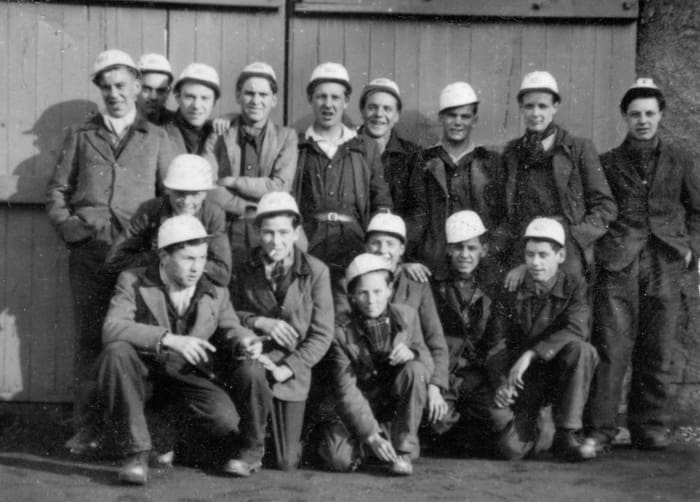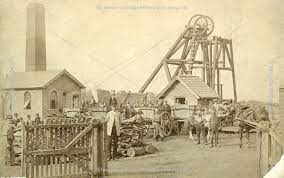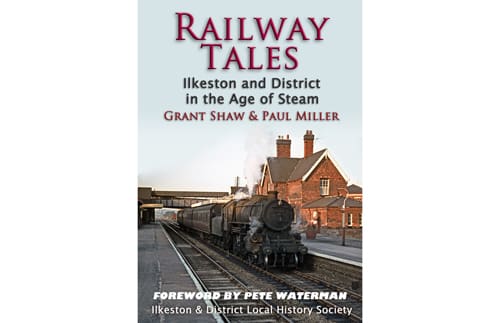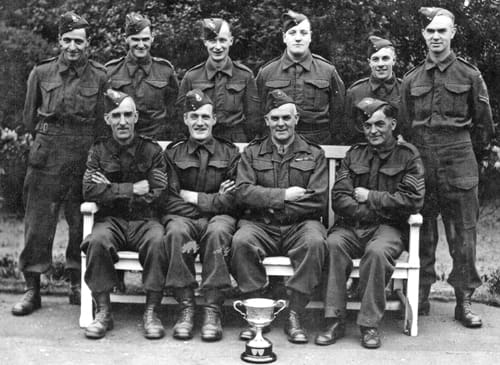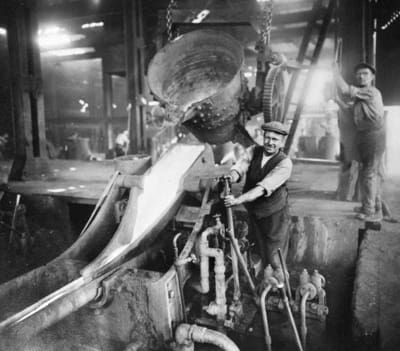Ilkeston lies almost at the southern end of the Nottinghamshire and Derbyshire coal field, with the deepest seams finally outcropping or bassetting out in the neighbouring parishes of Kirk Hallam and Stanton by Dale. Coals and probably ironstone also had been mined on a small scale in the area for centuries before their extraction became a major occupation. In a talk given to the Old Ilkestonians Society in 1937 the manager of the Mapperley Colliery Company, F M Brown, JP, claimed that coal was first mined in Ilkeston in 1300 ‘and had continued to be so ever since’. King Henry the Seventh sold land and the coal beneath it to John Savage in order to meet his expenses at the Battle of Bosworth (22 August 1485) and in 1645 a paper was given before the Royal Society on coal-getting in Ilkeston. Mr Brown also recalled the nick-names of some of the old pits, still remembered. Colliers were mentioned in the Fine and Suit Rolls of the Manor Court in 1571 and 1600 as being excused attendance at Court.
Early in 1602 a pre-nuptial settlement was made on the occasion of the intended marriage between Sir Thomas Savage and Elizabeth, daughter of the Right Honourable Lord Darcy of Chech. In order to secure the married couple during the lifetime of the groom’s father, Sir John Savage, the later pledged the Manor of Ilkeston and its coal mines in trust to produce for them a yearly rent of £50.10s. After the death of Sir John it was intended that his son would inherit this and a great deal of other property. In 1608 Sir Thomas Savage sold the Manor of Ilkeston to Sir John Manners, ancestor of the Dukes of Rutland. In 1616 articles of agreement were arranged between Sir George Manners of Haddon and John Gregge of Ilkeston whereby for a rent of £200, the latter was to have on lease the ‘the deep and bassett pitts’ already sunk on Rough (not be it noted Sough) Close and over 80-90 yards extent, with full liberty to sink another one, to be worked on a single shift only, and sufficient wood from the Moor, New Parke and Cotmanhay Reserves. He was to be protected from competition and allowed another 10 yards if necessary.
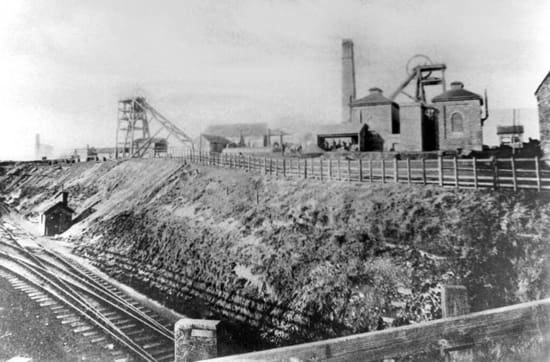
All of this was small beer compared to the operations begun in the last quarter of the 18th century. Once kept in the Plans Department of the National Coal Board at Eastwood Hall was a plan that had been made in 1815 of Part of the Manor of Ilkeston shewing the Colliery. As well as the later pit on Ilkeston Common belonging to James Potter and Gervase Bourne and, on the site occupied by Cotmanhay Wood, another ‘Engine Pit’ sunk in 1808, it showed an ‘Old Engine Pit’ 80 yards deep sunk in 1776 on land lying behind the site on the main Town Street that was afterwards occupied by the Poplar Inn. According to Cresswells Nottingham Journal, it had been sunk by Messrs Roe, Potter and Bourne. Further details of Messrs Potter and Bourne on Ilkeston Common can be found in the section on Transport.
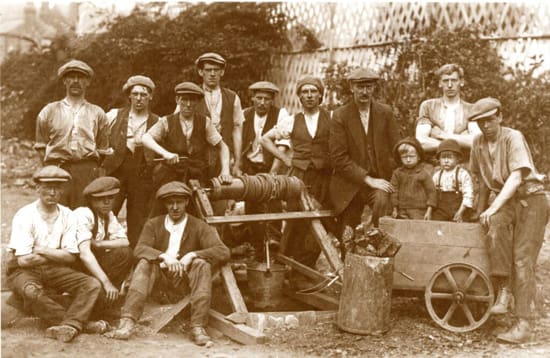
The next stage of development came with a lease taken from the Duke of Rutland by Samuel and Phillip Potter, whose pit shafts were shown on another Coal Board Plan of the Rutland Colliery Deep Soft Workings down to 1846. ‘Engine Pit No.1’, was sunk in 1828 in a field on the east side of Heanor Road behind the site occupied by Granby Schools, was variously stated to be 151 and 184 yards down to the Bottom Hard Seam. No.2 Pit was sunk in a field on the west side of Heanor Road behind the site afterwards occupied by Ilkeston’s first Hospital and No.3 Pit in 1837 farther west within the site later occupied by the Manners Colliery. Some time before September 1841, when J.T.Woodhouse completed his Plan of the Rutland Colliery, the ‘Bath Pit’ was sunk and later on ‘Rutland No.4 Pit’ close to the Manor House. The first large scale Ordnance Survey Plans which were produced in this area in 1879-80 showed a great many more ‘Old Coal Pits’ that had been opened up and abandoned. The more long lasting enterprises are mentioned below.
During the last years of the occupation of Little Hallam by the Flamstead family in 1824-9 a small colliery was opened south of the Derby Road, which was linked by tram-road to the Nutbrook Canal. Workings in the Furnace seam on this site were recommenced in 1872 by Harry Bostock and William Sudbury under a lease from the Rt Hon Edward Strutt, first Baron Belper, working for a short while in partnership as the Oakwell Colliery Company. Strutt had purchased all of the Flamstead lands around 1830. In 1874 a larger number of shareholders was taken in to form the stronger and more influential Ilkeston (Oakwell) Colliery Company Limited, working the deeper Kilburn seam. Recent advances in the price of coal at that time gave further impetus to mining enterprise in Ilkeston. The principal proprietors of the Rutland Colliery and others formed a new company, to be known as the Manners Colliery Company, for the purposes of sinking to the Kilburn coal, ‘a lower bed than any hitherto worked in Ilkeston’, and another company was in course of formation for a new colliery near Cotmanhay Wood. New pits had also been opened on the banks of the Nutbrook by the Rutland Company and by the West Hallam Coal and Ironstone Company and several other smaller (and short lived) operations had begun.
Incorporated as a Limited Liability concern in 1898, the Manners Company had been consistently successful down to 1926, with the exception of the years 1909, 1910, 1921 and 1925. During this period the output increased from 209,000 tons in 1900 to 458,000 tons in 1923. Dividends on Preference Shares were regularly paid up to July 1928 and substantial dividends were paid to the holders of the Ordinary Shares. In 1909 the Eight-hours Act came into operation and it took until the end of 1910 to reorganise the pits to meet the new conditions. The loss in 1921 was occasioned by a strike. The turning point in the financial history of the Company was the disastrous strike of 1926, when output fell to 226,000 tons and from that date onwards the Company made losses ranging from 1s to 3s.2d a ton per annum, in all amounting to £148,000.
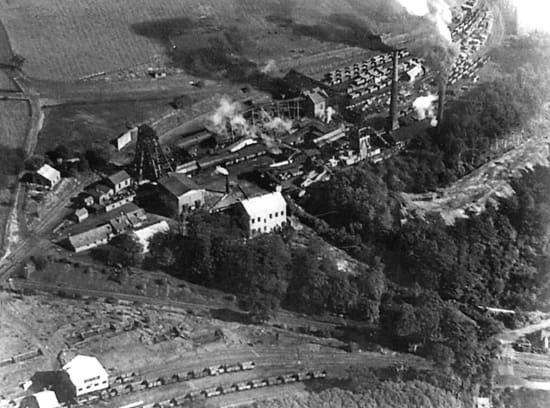
This later formed the site of the former ‘American Adventure’ theme park and is now housing.
These losses had been largely caused by the depression in trade and by the operation of the CCCA Scheme and later by Part One of the 1930 Act, both of which limited outputs and under the Act of 1930 minimum prices were fixed, often to the disadvantage of the Company. In order to concentrate outputs and to reduce expenses it was decided to close the Kilburn Pit. This was done in December 1931, leaving at work the Low Main, Piper and small quantity of Deep Hard and Deep Soft coals. In 1934 the assets of the undertaking were purchased by Shipley Collieries Ltd and renamed Ilkeston Collieries Ltd, the second time that this title had been used. Operations in Ilkeston seem to have ceased in 1949 and at the Company’s Lodge Pit at Newthorpe ten years later.
Shipley Collieries ceased working in 1966.
